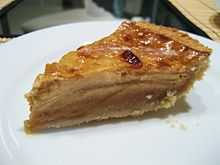Custard pie
| Custard pie | |
|---|---|
|
A coconut custard pie | |
| Type | Pie |
| Main ingredients | Pie shell, custard |
|
| |

A custard pie is any type of uncooked custard mixture added to an uncooked or partially cooked crust and baked together.[1] In North America, custard pie commonly refers to a plain mixture of milk, eggs, sugar, salt, vanilla extract and sometimes nutmeg combined with a pie crust. It is distinctly different from a cream pie, which contains cooked custard poured into a cooled, precooked crust.[2] Some common custard pies include pumpkin pie, lemon and buttermilk chess pie, and coconut custard. True custard is defined as a liquid thickened with eggs. Due to the often large number of whole eggs in custard pie it is a very rich pie.
History of custard
The Ancient Romans were the first to understand the binding properties of eggs. During the Middle Ages, the first custard pies, as we know them, began to appear. Initially, custards were used only as fillings for pies, pastries and tarts.[3] Both Europe and Asia had recipes that contained custards. The word custard is derived from ‘crustade’ which is a tart with a crust. After the 16th century, custards began to be used in individual dishes rather than as a filling in crusts.[1]
In 1837, an English chemist named Alfred Bird introduced a form of custard thickened with the powdered starch from corn (maize), a plant from the Americas. This became widely known as Bird's Custard, though it is not considered true custard because of this use of cornstarch instead of eggs. However, this is the main reason Bird’s custard became popular; because there were no eggs used there was no risk for the mixture curdling.[1]
During the 19th century in North America, custards and puddings were marketed as having health benefits. Among those specifically targeted were children and mentally disabled invalids. Ingredients stated to be healthy included tapioca and arrowroot. By the 1930s, instant pudding and custard were widely available to North Americans.[3]
Today, custards are used as filling in pies and tarts, and as individual dishes. Ideally a custard pie should be light and delicate, but still have good body. Custards can be made in two ways: baked or stirred upon the stove, but most custard pie recipes call for baking. The eggs in custard mixtures, when cooked, turn from liquid to solid. If cooked over excessive heat, the eggs will curdle, which is extremely undesirable. Curdling can be prevented by using lower temperatures and stirring. As such, making true custard pie is a very delicate process.
As a comedic device

- Custard pies thrown or pushed into the face are a comedic device used by clowns in many circus performances.
- Custard pies are also employed in practical jokes for harmless fun.
- The practice of 'flanning', or 'pieing' - throwing custard pies into the faces of public figures as a sign of disapproval - is well-known; its victims include designer Karl Lagerfeld, American singer Kenny Rogers, former Dutch finance minister Gerrit Zalm and media tycoon Rupert Murdoch.[4]
- The American billionaire Bill Gates was once filmed being struck in the face with a custard pie while attending a conference.[5] The attackers, who described themselves as 'pie terrorists', were later fined.[6]
- In the movie Bugsy Malone, the "splurge guns" fire custard.
- Other films notable for pie fight sequences include Laurel and Hardy's Battle of the Century, Beach Party, The Great Race and Smashing Time.
- UK Saturday morning programme Tiswas had custard pies as a regular feature and even had a character called The Phantom Flan Flinger, a masked man who pied people.
- The World Custard Pie Throwing Championships take place annually in the village of Coxheath in Kent, England.
See also
- Coconut pie
- Chess pie
- Cream pie
- List of custard desserts
References
- ↑ 1.0 1.1 1.2 "thenibble.com"
- ↑ "baking911.com"
- ↑ 3.0 3.1 "foodtimeline.org"
- ↑ "Flanning: Rich and famous get custard pie treatment". BBC News. 3 February 2000. Retrieved 2007-08-27.
- ↑ "Bill Gates and the Custard Pie: Film Clip". Retrieved 2007-08-27.
- ↑ "'Pie terrorists' fined for Gates attack". BBC News. 5 January 1999. Retrieved 2007-08-27.
